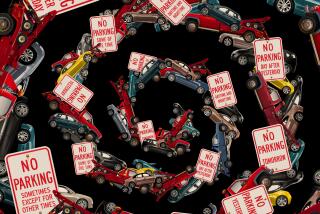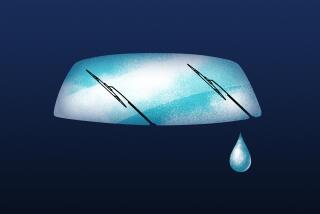The Truth at the End of the Road
VAN NUYS — Let the automobile companies harp on the virtues of their products, depict them on stunning landscapes, bathe them in music and insinuate them into the deepest recesses of our desiring.
The real truth about cars--the final truth--is to be found in places like Van Nuys Auto Wrecking.
The company is one of an estimated 400 active auto dismantling operations in Southern California, the congested cardiopulmonary center of the American car culture and the wrecking industry. These automobile boneyards, like their human counterparts, are the end of the road for sham and pretense; the places the paths of hyperbolized sheet-metal glory lead but to.
Jim Steinert, who practically grew up in the Van Nuys wrecking yard his father, Pete, has owned for three decades, knows just about every axiom and corollary of the final truth.
Every month, about 300 cars enter the cramped, two-acre lot, and another 300, flattened to the door line, are trucked off to become scrap. At any given time as many as 400 are being kept on-site as donors of internal organs and extremities.
The new state law requiring all vehicles to be insured before they can be re-registered has tripled the number of clunkers that have been offered to Van Nuys Wrecking since January.
“People are thinking, ‘Hey, if I got to spend $50 a month to insure it, I might as well get a new car,’ ” Steinert says. “The one problem we don’t have is not having enough cars. I have to tell people a couple of times a week we can’t take any more.”
The swelling of supply has meant Steinert can acquire cars somewhat more cheaply, and that increasing numbers of them come in under their own power rather than DOA.
Certain models, Steinert says, light up a wrecker’s eyes because so many of their ilk are still running and in occasional need of the odd component.
“Trucks in general, especially mini-trucks, are good to get,” Steinert says. “Also Nissans, Toyotas, Hondas, all minivans. We get cars in here that, on the first day, we’re taking parts from, and within a week, they’re stripped.”
A good example, he says, is a wrecked, gray 1989 Nissan pickup truck at the edge of the narrow, dirt driveway in back. After paying about $500 for it, Van Nuys can expect to receive $600 for the motor, $300 for the transmission, $200 for the differential, $50 for each door window, $35 for each window crank, and $35 for each window regulator--all of which are in demand.
Of course, Steinert points out, other cars prove useless except as scrap, which brings between $40 and $50 a ton, and may not cover costs. “Most cars are usually worth at least a hundred bucks,” Steinert says, “but I’ve seen cars come in here that were worth zero.”
At 34, Steinert has developed a keen sense not only of marketable parts, but of the life spans and peculiar deficiencies of various models.
“They started selling Hyundais in ‘86,” he says, “and about four years ago we started getting lots of them. Those cars were lasting six or seven years--I mean cars that looked perfectly new, but their motors were junk.
“Escorts, on the other hand, last much longer. I still do business in Escorts from 1986 and 1987--they’re lasting 10 years. Same way with the VW Rabbit. A lot of people thought they were not good cars, but I’m getting ‘81s and ‘82s that still run great.”
Monitoring the actuarial realities of cars has convinced Steinert that front-wheel-drive cars--easier to make, easier for unskilled drivers to handle and much promoted by manufacturers--are inferior to traditional rear-wheel-drive cars.
They have transmission and differential problems, he says, and pass into his hands and those of his professional brethren before their time.
The best cars, in his opinion, are (no surprise) Mercedes-Benzes and BMWs, and--big surprise-- the oft-maligned rear-wheel-drive behemoths that once were the hallmark of the American car makers.
“Those rear-wheel-drive, V8 American cars from the ‘70s, ‘80s and ‘90s, they run forever,” he says. “I still see ’75 Chevys coming in here all the time. Also Cutlasses, Regals, Monte Carlos, Ford LTDs, Mercury Marquises and the big Cadillacs, like the Coupe de Ville.
“The old design with the engine in front, the transmission behind it and the drive shaft and differential in back, every major quality car--every Mercedes, every BMW and Jaguar--is still built that way.”
Among the wrecking cognoscenti, certain cars are notorious for personality flaws--for example, pre-1992 Ford Tauruses and Mercury Sables (“their trannies are bad”), all Audis (“a good car, but a complete failure in the making-the-windows-go-up-and-down department”).
Steinert stresses he’s not pointing the finger at specific manufacturers. Most, he says, make at least one model that has something curiously wrong with it.
His own wheels are a used 1991 Toyota MR2, rear-wheel drive, of course.
“After seeing how the car business operates, I’d never buy a new car,” he says. “Of course, not everyone has the opportunities I do, but I have the distinction of saying I’ve never lost money on any car I’ve ever owned.”
Besides, being on the philosophical end of the industry, Steinert has a broad and accepting view of the fundamental reality. “Every car,” he says, “gets to the point where it’s no longer a dependable car.”
Sooner or later, every car rolls or limps or is towed into places like his to be dismembered and allowed to corrode, then to be crushed, scrapped and sent to steel companies’ furnaces for transformation into refrigerators and washing machines--even perhaps into brand-new cars that will repeat the cycle.
Ashes to ashes, in other words. Rust to rust.






